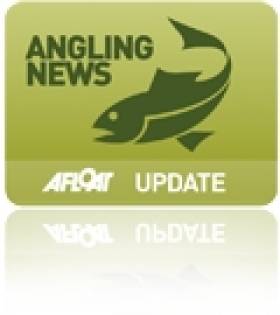Displaying items by tag: Omagh
Rivers in Omagh Area Reinforced Following Loughs Agency Works
The Loughs Agency has completed river enhancement works on several rivers in the Omagh area in Northern Ireland in partnership with local landowners, the Omagh Anglers Association and Strule Tributaries and Rivers Trust.
Loughs Agency chief executive Sharon McMahon said: “Since the major flood event in 2017, the agency has worked extensively to reduce silt in rivers, predominantly through working with farmers and landowners at a catchment level to protect riverbanks from excessive erosion.
“Siltation is less obvious than pollution events that are often reported, but it can significantly affect the sustainability of the fishery.
“This project demonstrates how partnership and using nature-based solutions can relieve some of the pressures on the fishery.”
One enhancement project was at a section of the Camowen River known as Bertie Anderson’s. The stretch had suffered bank slippage due to a combination of public and livestock access over the years. The subsidence resulted in silt entering the river and narrowing the channel.
Soft engineering works were completed by installing 60 metres of root wads to help stabilise the bank. The locally sourced wads will help to catch and reduce silt in the river and revegetate the bank.
Forty metres of vertical larch timber piles were also driven into the edge of the river along with horizontal poles to protect the base of the riverbank.
Salmon survival can be significantly affected by suspended solids entering the river due to bank erosion. This is due to salmon eggs becoming smothered by silt during the winter following soil erosion and run-off.
Downstream of this site, there is fantastic spawning habitat. However, bank erosion here has resulted in siltation which is impacting downstream spawning beds.
This soft engineering project will reduce erosion and act as a siltation trap, collecting suspended soils travelling down from upstream, the agency says.

Hard and soft engineering solutions were also used in other sites in the Foyle catchment. The Owenkillew, Quiggery, Glenelly, Cloughfin, Fintona, Altinagh, Routing, Granagh, Aghlisk and Glensawisk Rivers have also had habitat enhancement projects this year via local and stakeholder partnerships.
Terry Smithson of Omagh Anglers Association was delighted to work in tandem with other organisations to complete these works.
“We took the opportunity to work in conjunction with Loughs Agency and a local landowner on the Camowen project,” he said. “This work complements previous work undertaken by the club in the upper reaches of the Camowen on the spawning grounds and annual access works.
“It is great to see what can be achieved when we all work in a partnership to protect the holding pools, spawning beds and nursery streams."
Shane Colgan of the Strule Tributaries and Rivers Trust added: “We have been working with Loughs Agency in recent years on schemes to help create and reinstate habitat throughout the upper reaches of the Strule catchment.
“Works were carried out primarily to rehabilitate Atlantic salmon habitat but will benefit an array of riparian species, both flora and fauna. The schemes involved remedial bank revetment in helping alleviate the damage after several flooding incidents.”
For more information on the river enhancement projects, visit the Loughs Agency website HERE.
Mellon Beat Opens To Anglers On First Day Of April
#Angling - The fishing season opens tomorrow (Wednesday 1 April) at the upgraded Mellon Beat in Co Tyrone, with angling opportunities for salmon and wild brown trout amid one of the most relaxing and picturesque spots in the island of Ireland.
Close to Omagh, the Mellon Beat enhancement project is one of several Loughs Agency marine tourism and angling development schemes funded through a £4 million programme of investment derived from the European Union's INTERREG IVA programme, managed by the Special EU Programmes Body.
The in-stream works include groynes and revetment placed in the River Strule as habitat enhancement for fish and other river life.
Angler access improvement works include a car park, timber steps to the river, signage, stock-proof fencing, gates and stiles, angler shelters, bench seating and a water depth gauge.
The fishing season opens on Wednesday 1 April and day tickets can be purchased from CA Andersons at 64 Market Street, Omagh (Tel: 028 8224 2311) and D Campbell, 12 Killymore Road, Newtownstewart, Omagh (Tel: 028 8166 1543).






























































